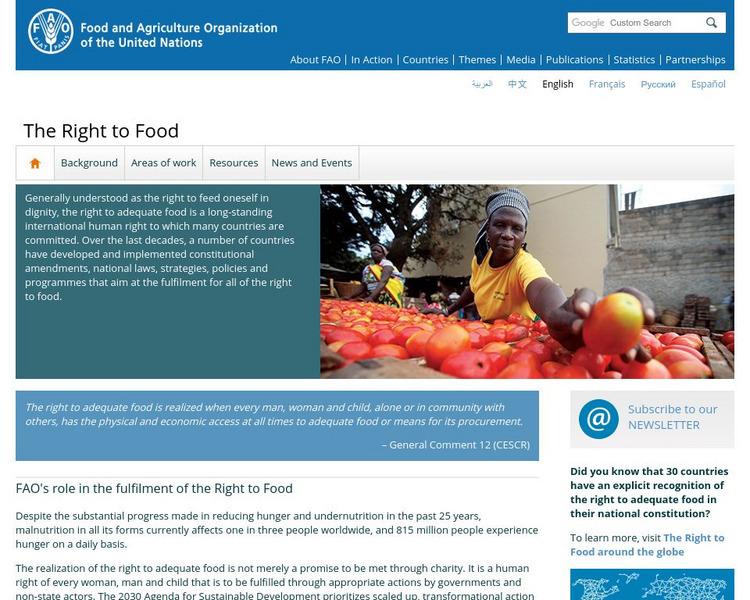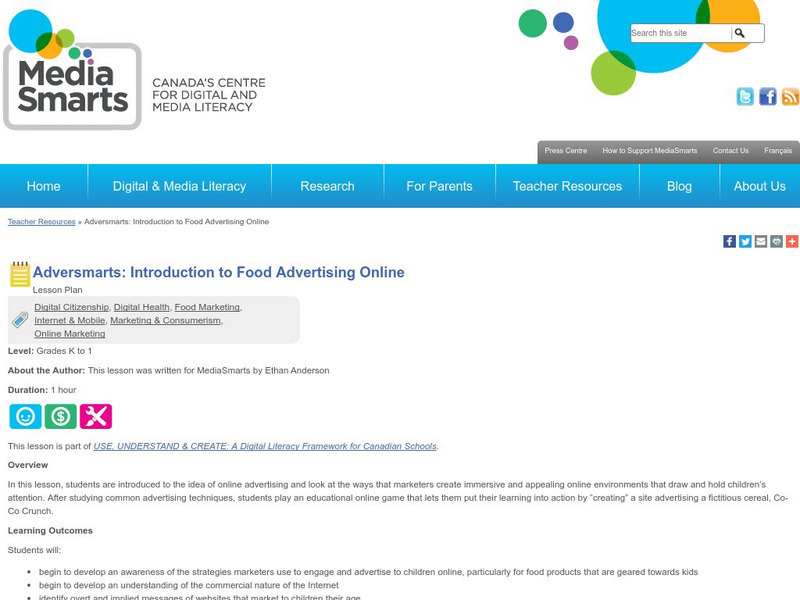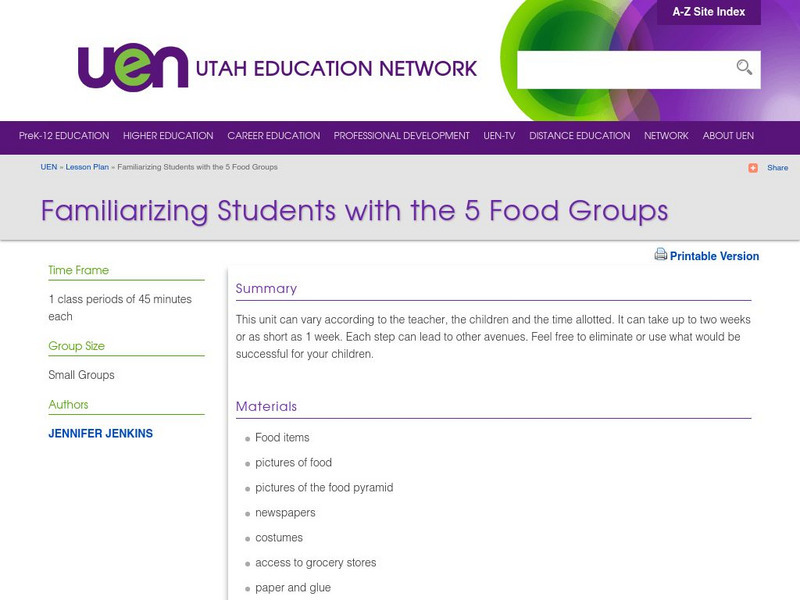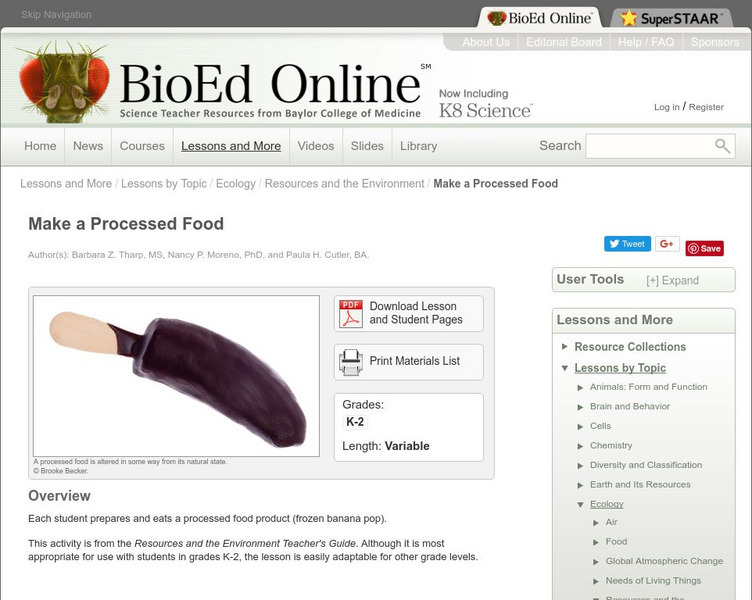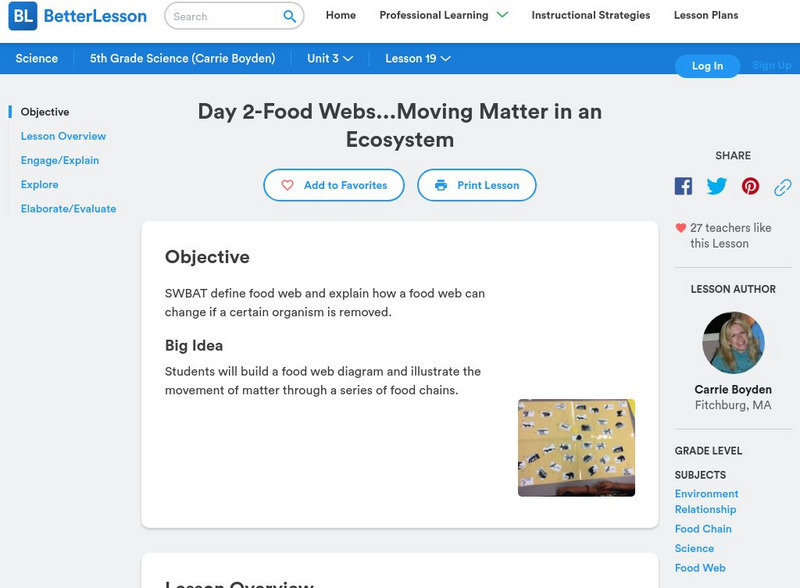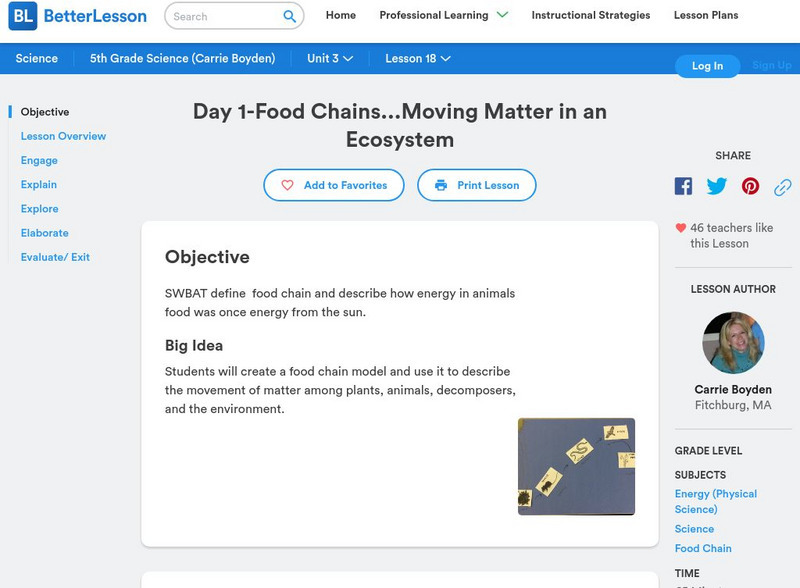Hi, what do you want to do?
Food and Agricultural Organization of the United Nations
Food and Agriculture Organization of United Nations: The Right to Adequate Food
One basic life concept is that every person has the right to adequate food. Using this interactive site, find out more about this by exploring the tabs underneath the title. The Resources section has learning resources, including...
BioEd Online
Bio Ed Online: Raw vs. Processed Food
In this lesson young scholars will gain an understanding of what "processed" means. They will also distinguish between natural and processed foods, and learn about sources of some foods.
Media Smarts
Media Smarts: Adversmarts: Introduction to Food Advertising Online
Media Smarts provides digital and media literacy lessons for learners. In this instructional activity, young students will learn about online advertisements targeted to children. Learners will play on online game; they will create an...
Utah Education Network
Uen: Familiarizing Students With the 5 Food Groups
This module provides a multiple-day unit about the five food groups. Teachers of the unit will explicitly teach students about analyzing charts. Then students will gain exposure with written and visual resources to help apply the...
BioEd Online
Bio Ed Online: Resources and the Environment: Make a Processed Food
Students learn the difference between natural and processed foods when they make a frozen banana pop dipped in chocolate sauce.
Better Lesson
Better Lesson: Food Webs Moving Matter in an Ecosystem(day 2)
Students will build a food web diagram and illustrate the movement of matter through a series of food chains. Resources include detailed plans, examples of student work, videos of the lesson in action, and sample food webs.
Better Lesson
Better Lesson: Food Chains Moving Matter in an Ecosystem (Day 1)
Students will create a food chain model and use it to describe the movement of matter among plants, animals, decomposers, and the environment. Resources include a detailed lesson plan, student handouts, pictures of a completed chain,...
Texas Education Agency
Texas Gateway: Organism Relationships: Food Chains, Webs, Pyramids
Given illustrations, students will analyze the flow of matter and energy in food chains, food webs, and ecological pyramids.
PBS
Pbs: In Defense of Food Curriculum
PBS: In Defense of Food Curriculum. It is designed to help adolescents develop something valuable:practical tools for healthier eating. It helps students learn why it is important to eat healthfully, investigate how food companies...
PBS
Pbs Learning Media: Lesson 10: Eat Food. Not Too Much. Mostly Plants.
In this final lesson a clip from In Defense of Food shows students the vibrant food movement that is springing up across the country. In a final celebration, students share their final projects with the class and think about how they can...
CommonLit
Common Lit: Genetically Modified Salmon: Food or Frankenfish
CommonLit.org is a wonderful resource to use in a Language Arts classroom. Each story or article is accompanied by guided reading questions, assessment questions, and discussion questions. In addition, students can click on words to see...
Concord Consortium
Concord Consortium: Stem Resources: Predators and Prey
Did you ever want to be a hawk? In this virtual ecosystem, students will take on the role of a hawk and try to catch rabbits on a snowy field. Students will see which rabbits have adaptations that allow them to blend into the environment...
New Zealand Ministry of Education
New Zealand Government: Te Kete Ipurangi: Is Food a Technological Outcome?
In response to a misunderstanding about whether food can be a technological outcome, students were given an exploratory lesson in food technology. They discussed biscuits as technological products and the testing and trialing involved in...
University of California
Ucla: Student Nutrition and Body Image Awareness Campaign
Students learn about food, nutrition, fitness, and how to balance health and college activities. Topics included are weight, fitness, diet, nutrition, and body image. The resource consists of information on workshops, classes,...
Ingles Mundial
Ingles Mundial: Food (La Comida): Listening/dialogs
Wonderful, extensive site for Spanish-speaking ELL. In this section, students listen to a couple of short audio clip dialogs in English and then answer interactive comprehension questions. Several activities provided - instructions in...
Alabama Learning Exchange
Alex: Edible Alabama and Her Agricultural Resources
This is a great culminating activity after a unit study on the natural resources of the state of Alabama. Learners will investigate some of Alabama's agricultural resources and create a multimedia presentation about one of them or recipe...
PBS
Idaho Ptv: Science Trek: Food Web
A comprehensive overview of food webs. Includes three videos: a half-hour show, a video short, and a short video where an expert answers children's questions. Other features of the site include facts, links, games and activities, a...
Other
Population Connection: Food for Thought [Pdf]
This lesson plan and activity will demonstrate how differences in population and resource use combine to affect a population's quality of life. Population demographics, land use patterns, energy, and wealth are explored to increase...
Other
Baltimore Co. Public Schools: Chesapeake Bay Food Webs (Online Research Model)
Food webs lesson, which focuses on Chesapeake Bay habitats, integrates biological concepts with literacy knowledge and skills. Lesson directs students to answer the question, how does a human-caused stress placed on the environment...
John F. Kennedy Center
The Kennedy Center: Beyond Food & Fiestas: Creating Authentic Cultural Experiences in the Classroom
As educators, we are eager to provide cultural experiences for our students. Songs, dances, traditional dress, food, and relevant objects are wonderful ways to interest students in a variety of cultures. But when you take it a step...
PBS
Pbs Learning Media: October 16th Is World Food Day
Around the world, 870 million people do not have enough to eat, according to the U.N. World Food Program. Use this PBS NewsHour Extra lesson plan to help students understand the global food crisis. Support materials are provided.
PBS
Pbs: The Lowdown: Rot and Rubbish: The Rancid Truth About How Much Food We Waste
Explore the math of worldwide food waste, with focus on percentage, in this infographic from KQED. In the accompanying classroom activity, students predict the percent of food in each of the various categories (e.g., grains, fruit, etc.)...
Concord Consortium
Concord Consortium: Gene Environment Interaction: Food and Sand Rat Health
Students explore the effect of both genes and environment on the health of sand rats, a model for studying diabetes in humans.
Science Education Resource Center at Carleton College
Serc: Life in Extreme Environments: Who Is on Top in the Food Chain?
In this lesson, learners will design experiments to gain some understanding of the feeding rates of Rotifers and/or Tardigrades. They will use organisms collected locally or provided by the teacher to explore differences between their...





